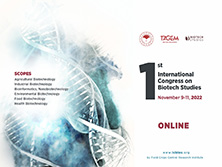Biotech Studies
2021, Vol 30, Num, 1 (Pages: 022-032)
Role of grafting in tolerance to salt stress in melon (Cucumis melo L.) plants: ion regulation and antioxidant defense systems
2 Graduate School of Natural and Applied Sciences, Cankiri Karatekin University, 18100, Cankiri, Turkey
3 Department of Horticulture, Faculty of Agriculture, Ankara University, 06110, Ankara, Turkey DOI : 10.38042/ biotechstudies.932376 - Grafting in vegetables is a method that has been commonly used in recent years, not just for the treatment of soil borne diseases and pests, but also to facilitate higher abiotic stress tolerance under conditions such as salinity. Herein, it was aimed to determine if the salt tolerance of two salt-susceptible melon genotypes, SCP-1 and SCP-2, could be improved by grafting onto TLR-1 and TLR-2, which are salt-tolerant melon genotypes, and Albatros commercial melon rootstock. The grafted plants were grown in plastic pots containing a peat: perlite mixture and exposed to NaCl at doses of 0 and 200 mM under greenhouse conditions. The salt-tolerant rootstock significantly diminished the damaging effects caused by salt stress via a reduction in the uptake of Na and Cl, which enhanced Ca and K uptake and micronutrition. Stress-induced activities of catalase, superoxide dismutase, ascorbate peroxidase, and glutathione reductase were considerably higher in the grafted plants. The results showed that grafting salt susceptible plants onto the salt-tolerant rootstock improved the growth regulation. The salt tolerance of the grafted melon seedlings may have partially been the result of the decreased Na and Cl, and malondialdehyde contents and higher antioxidant enzyme activities. Keywords : Cucumis melo Grafting Ion accumulation Rootstock Salinity
















